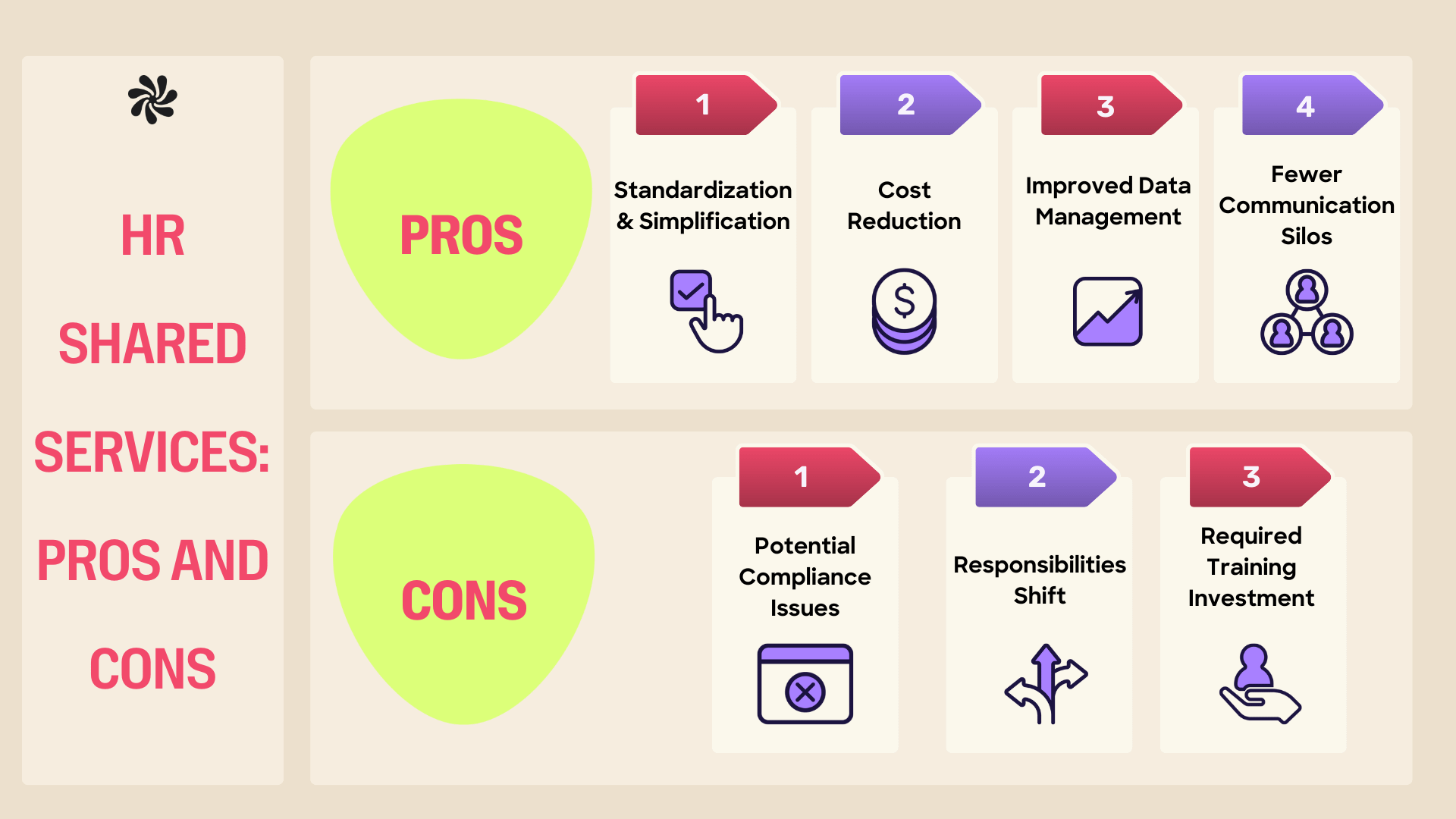Are HR Shared Services Right For Your Company? The Good and the Bad.
Last Updated Jan 28, 2025

Is your team drowning in a sea of repetitive HR tasks? You’re not alone. About burnout/#:">40% of employees feel burned out</a> due to ineffective systems and processes, according to Qualtrics.
Thankfully, this doesn’t have to be your forever story. With efficient HR services, you can make life easier for you and your employees.
HR shared services may be the painkiller for the headache of overwhelming tasks. Centralizing HR tasks can make things run more smoothly and consistently. Plus, it saves your company time and money, allowing employees to focus on what really matters — hitting organizational goals.
But what are HR shared services anyway? And how can they help you boost your team’s productivity and work-life wellness?
Let’s dive in to find out!
What Are Shared Services in HR?
HR shared services are automated, centralized platforms that handle various HR functions. Think of HR shared services as a hub that takes on overwhelming tasks to deliver streamlined HR services that boost your employees' experience.
HR shared services can improve communication across departments by allowing employees to access information from a central place. Plus, kpis/">tracking and analyzing HR data</a> is easier — you don’t need to comb through different databases to access employees' data.
Some of the functions HR shared services can help with include:
- Processing payroll bonuses and deductions
- Job posting and recruitment processes
- Assisting with employees' conflict resolution and management
- Planning and organizing employees' training and skills and career development
- Administering employee benefits such as insurance policies, retirement plans and health care benefits
When Should HR Leaders Consider Shared Services?
HR shared services can reduce workload, allowing employees to focus on more productive tasks and have time for self-care. However, these services may not be practical for a business in some instances.
Here are some pointers to show if shared services make sense for you as an HR leader.
When You Have a Rapidly Growing Business
When your business expands, the demands on your HR department increase as well. You might find that you need more HR professionals to manage the expanding workforce and the higher volume of HR tasks. During such a time, shared HR services will come in handy.
Shared HR services allow you to automate and centralize HR functions such as payroll and benefits administration to improve efficiency across your organization. Your special HR team can then focus on other strategic activities that require direct human intervention.
But that’s not all. With shared HR services, managing employees becomes a breeze. All the employee data is stored electronically in a central place. This means you can easily track and analyze trends, identify common issues, and even respond to employee concerns in a consistent and timely manner.
When You Want to Save Time and Money
Shared HR services may seem expensive — based on the initial investment. But the truth is, they help you save in the long run.
For starters, you don’t need a big team of HR professionals to handle repetitive HR tasks. Proper shared HR services allow you toautomate these tasks with great efficiency. This means you can save the money that you’d have spent on acquisition and labor costs.
In addition, shared services help you save time and streamline your employees' experience. When automation tools take care of some of the HR work, it saves your employees hours and hours of work. As a result, they can focus on more meaningful work without getting overwhelmed, which improves the productivity of your organization.
Without shared services, your employees’ mental wellness is at risk. Imagine a scenario where a team of five HR professionals are serving more than 150 employees on a case-by-case basis. This would max out their energy and affect their output and wellbeing.
When You Want to Enhance Consistency
You don’t want to gamble with consistency when it comes to HR-related issues. Shared HR services allow you to operate from a central point to avoid conflicts between departments or employees.
Doing things uniformly across your company means treating all employees equally and fairly so they can feel valued. It also boosts confidence and trust among your workers — they know there are no special exceptions.
On top of that, shared services break communication barriers across departments since managers can access the same information. It’s therefore easy for teams to collaborate or comply with company policies.
Consistency in HR matters can enhance employees' experience, leading to higher retention rates. With higher employee retention, you cut costs in hiring and training new employees.
What Are The Advantages of HR Shared Services?

When considering whether to add shared services to your company, it’s important to take into account HR goals and objectives. If the advantages match the needs of the business, it might be worth considering a tech solution.
Standardization and Simplification of HR Approaches
Shared services help companies create a uniform approach across their departments and teams. About 87% of HR leaders aim to use shared services to improve their standardized workflows, a study by Deloitte found. When processes are consistent, it leaves less room for error. It also means all processes run through the same protocol, which helps managers access information easily.
Cost Reduction
Cost reduction is the number one outcome achieved when HR departments use shared services, a according to Deloitte. HR platforms eliminate the need to hire specialists for singular tasks, lowering the department’s operational cost. It also helps companies save time and resources by automating routine tasks, improving efficiency.
Better Data Management & Analysis
Centralized data makes tracking and analyzing HR metrics easier. When all data is stored and collected in the same place, managers don’t need to resort to searching through ten different platforms. This can help improve productivity. Real-time data also helps organizations make informed decisions by equipping HR with the workforce information it needs to better analyze the company’s operations and competencies.
Improves Communication By Breaking Down Department Silos
HR Shared Services help break down departmental barriers. They facilitate access to the same information across all departments, leading to improved communication and collaboration among teams. This, in turn, creates better workflows and enhances overall efficiency. This centralization can help HR specialists compare department or branch results against established benchmarks and measures, which help identify improvement opportunities and successes.
What Are The Disadvantages of HR Shared Services?
As with any other technology-driven model, there are some downsides to using HR-shared services that you might want to consider before making your decision.
Standardized Approaches Can Lead To Compliance Issues
Sometimes a one-size-fits-all approach can cause problems. For example, states may have different approaches to tax compliance and benefits. This means that one shared service might not be the best for all states in which a company operates.
Additionally, some global companies might not be able to work with centralized services because they can't handle employee data from different countries due to cybersecurity or data protection laws. In cases like these, using more than one tool for payroll oversight and tracking may be a better approach, even if it requires additional monitoring to avoid knowledge gaps.
HR Responsibilities Shift to Untrained Managers
When HR practices become automated and centralized, it's easy for some of the responsibilities to fall into the hands of employees or managers. While yes, the purpose is for shared services to be accessible to everyone, it’s best if the maintenance of HR systems and practices stay in the hands of HR specialists.
For example, if too many employees ask for the same days off work for holidays, it could lead to confusion and delays in projects due to the high level of absence. Here, HR professionals might need to step in to regulate time off available for it to be fair for the entire workforce.
Successful HRSS Requires Investment In Training HR Professionals
Companies need HR specialists with knowledge on platforms and people management in order to properly deploy these services. This may mean training for their HR professionals on new software, including overviews of the data they're working with education on relevant regulations.
HR professionals with experience using HRSS are better able to optimize their skills and tasks. When they understand all the functions of a system, they can find improvements, ensure compliance, troubleshoot whenever there's a hiccup.
How to Implement HR Shared Services (Step by Step)
Shared services are not one-size-fits-all. The implementation process will look different depending on your organization’s needs and your desired customizations.
That said, here’s a simple step-by-step process you can follow.
Step 1: Assess Your Needs
Evaluate your organization and your human resource department to identify any gaps in service delivery. Some critical questions you can ask at this stage are:
- What do we need to achieve?
- Are there any financial benefits?
- How does this impact our business?
You can ask your employees to give their opinions or brainstorm possible ideas to achieve your goal.
Step 2: Create a Detailed Design
Once you have a clear objective and understand the benefits for your organization, it’s time to design a working framework. First, define how you’ll separate shared services from core services and who will be responsible for each.
At this point, an important question is whether to outsource the shared services to third parties or have an in-house hub. This decision will guide you when specifying the resources and technology you might need for the shared services. It will also inform your strategy for educating and training employees to effectively manage the shared services team.
Step 3: Integrate and Test the Design
The third step is integrating and testing the design to identify major inadequacies. The best way to do this is to test a few services at a time to see how the design and tools work together. Ensure the employees handling the services have the resources (user guides) and support they need.
The process may take time and intense monitoring to ensure everything works as it should before it goes live.
Step 4: Implement and Roll out
Like in the testing stage, migrating a few services at a time is better than cramming everything together. Migrating in stages minimizes major disruptions while allowing employees to adjust to the new system. That means you won’t waste much time or use additional resources if the design doesn’t kick off as expected.
For instance, you can start with the most common services, such as payroll processing, and progress to other tasks as the system takes shape.
Step 5: Ask for Feedback and Deal With Upcoming Issues
While this is not an actual step, preparing for eventualities can save your organization time and money. It’s also a perfect way to get feedback from the employees in charge of shared services and those using the services. The feedback will help you deal with any issues promptly and identify areas for improvement.
Best Practices for Optimizing HR Shared Services
How do you get the most out of your organization’s HR shared services? By following tried-and-tested practices! And you can always tweak them to fit your changing needs and requirements.
Here are some proven approaches to make your HR shared services work even better.
Use Up-to-Date Technology
Shared HR services go hand in hand with technology. So, invest in recent technological software to enhance service delivery and reap the most benefits from your system. Whether you plan to outsource the services or build an in-house hub, ensure the technology you use is efficient, up-to-date, and easy to use.
Centralize and Standardize Information
The key feature of shared HR services is centralization. It allows easy access to information for all stakeholders in your company. More importantly, standardizing information enhances consistency and equality in your HR operations so no one feels left out.
Communicate, Communicate, Communicate
Most people don’t like change, especially when they think it threatens their livelihood. Some of your employees may be against HR shared services because they believe the platforms are coming to replace them.
It’s your duty to allay these fears.
Before optimizing for shared services, talk to your employees, especially those in the HR department, about what you’re doing and why you’re doing it.
At the same time, educate other employees on how the services work and their negative and positive effects. Also, ensureopen communication between the HR shared services and other departments to quickly solve any issues that may arise.
Invest in the Workforce or Outsource Where Necessary
The workforce behind your shared HR services determines their success. So, invest in proper training for the employees in charge of the services and provide them with the necessary resources.
Alternatively, you can outsource the services to third parties. But to get the most out of your investment, ensure the providers you choose are credible and reputable.
Automation Makes Time for What Really Matters: Employee Wellbeing
Automating administrative tasks with HRSS gives HR time to focus on what really: their team's health and wellness. After all, 99% of HR leaders with a workforce wellbeing program says it increased employee productivity.
Wellbeing programs are like an HRSS for employee wellness. They give your workforce tools to take care of themselves mentally and physically, which ultimately helps improve your organization's performance. As revealed in Wellhub's Return on Wellbeing 2024 study , 95% of companies see a positive return on wellness spending — and more than half see $2 returned for every $1 invested.
Wellhub can help you support employee wellness. With flexible plans that accommodate remote and in-person teams, employees access thousands of wellness partners — from nutrition tracking to gym subscriptions to mindfulness resources. Connect with a Wellbeing Specialist today so we can help you automate workforce wellness!

Company healthcare costs drop by up to 35% with Wellhub*
See how we can help you reduce your healthcare spending.
[*] Based on proprietary research comparing healthcare costs of active Wellhub users to non-users.
You May Also Like
- The Ultimate Guide to Human Resources
- Are HR Shared Services Right For Your Company? The Good and the Bad.
- Your Complete Guide to HR Tools: 20 Tool Categories
References
- Chartered Institute of Personnel and Development. (n.d.). Shared services factsheet. Retrieved June 17, 2024, from https://www.cipd.org/en/knowledge/factsheets/shared-services-factsheet/
- Deloitte (2021) A paradigm shift in HR shared services model: Digital delivery. . Deloitte. Retrieved June 17, 2024, from https://www2.deloitte.com/content/dam/Deloitte/xe/Documents/human-capital/me_hr-digital-shared-services.pdf
- Deloitte. (n.d.). HR digital shared services: Driving value through digitization. Retrieved June 17, 2024, from https://www2.deloitte.com/content/dam/Deloitte/xe/Documents/human-capital/me_hr-digital-shared-services.pdf
- Deloitte. (n.d.). HR digital and shared services. Retrieved June 17, 2024, from https://www2.deloitte.com/content/dam/Deloitte/xe/Documents/human-capital/me_hr-digital-shared-services.pdf
- Indeed. (n.d.). HR shared services: Career development. Retrieved June 17, 2024, from https://uk.indeed.com/career-advice/career-development/hr-shared-services
- Human Capital Institute. (n.d.). Optimizing shared services: Efficiency and effectiveness. Retrieved June 17, 2024, from https://www.hci.org/webcast/optimizing-shared-services-efficiency-and-effectiveness
- Lace Partners (2022) HR Shared Services Trends 2022 Report. Lace Partners. Retrieved June 17, 2024, from https://lacepartners.co.uk/hr-shared-services-trends/
- Qualtrics. (n.d). The ultimate guide to employee burnout. Retrieved June 17, 2024, from https://www.qualtrics.com/experience-management/employee/employee-burnout/#
- Society for Human Resource Management. (n.d.). Worker mental health challenges pose a productivity risk for HR. Retrieved June 17, 2024, from https://www.shrm.org/executive-network/insights/worker-mental-health-challenges-productivity-risk-hr
- Xuecheng, W., Iqbal, Q., & Saina, B. (2022). Factors affecting employee's retention: Integration of situational leadership with social exchange theory. Frontiers in Psychology. Retrieved June 17, 2024, from https://doi.org/10.3389/fpsyg.2022.872105
Category
Share

The Wellhub Editorial Team empowers HR leaders to support worker wellbeing. Our original research, trend analyses, and helpful how-tos provide the tools they need to improve workforce wellness in today's fast-shifting professional landscape.
Subscribe
Our weekly newsletter is your source of education and inspiration to help you create a corporate wellness program that actually matters.
By subscribing you agree Wellhub may use the information to contact you regarding relevant products and services. Questions? See our Privacy Policy.
Subscribe
Our weekly newsletter is your source of education and inspiration to help you create a corporate wellness program that actually matters.
By subscribing you agree Wellhub may use the information to contact you regarding relevant products and services. Questions? See our Privacy Policy.
You May Also Like

What Is Human Resources Responsible For? | Wellhub
Explore what HR does—from hiring and benefits to employee relations, training, and wellbeing—with common job titles and team structure explained.

8 Most Common HR Complaints & How to Handle Them | Wellhub
Get ahead of employee HR complaints. Here are the eight most common complaints and how to handle them.

5 HR Trends Reshaping the Workplace in 2025 | Wellhub
These are the latest HR trends transforming work in 2025, from AI integration to hybrid work models. Use these strategies to keep your org ahead of the curve.